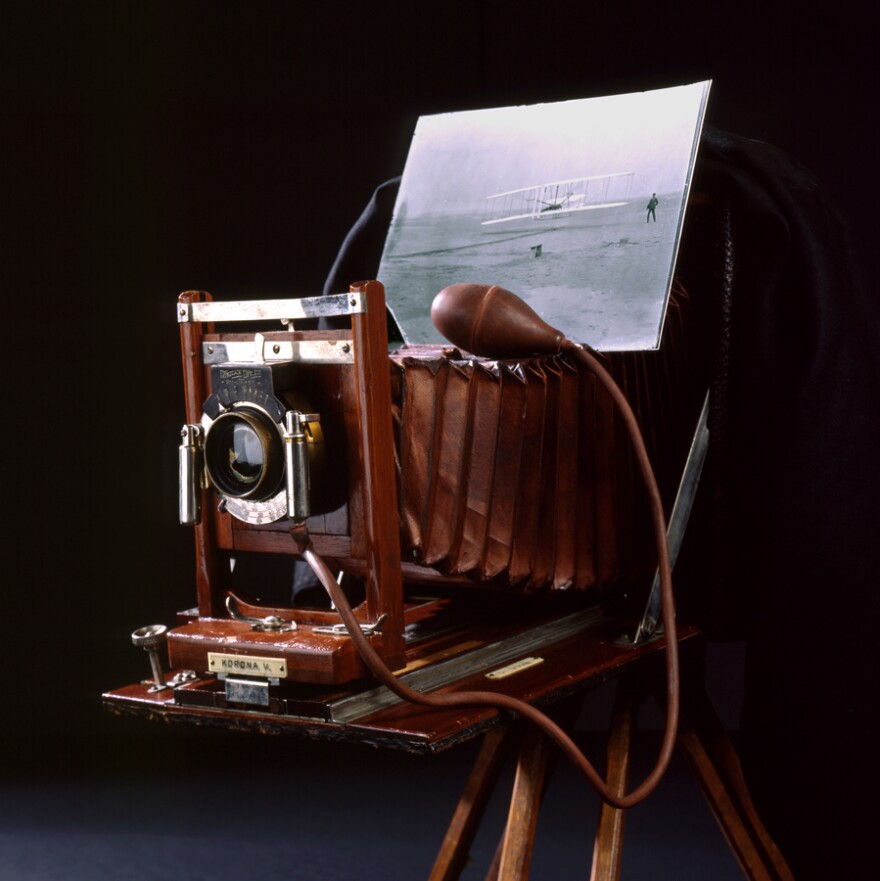Today is perhaps the most important date in aviation history. It was 10:35 in the morning on December 17, 1903, when Orville Wright flew a powered aircraft on the sands near Kitty Hawk, North Carolina. It was a short flight - with huge consequences. Dayton aviation historian and photographer Dan Patterson knows the story well.
Another accomplishment that day was the creation of a single photograph, which is arguably the most recognized photo in history. The brothers asked Kitty Hawk Life Saving crewman John T. Daniels to stand with the camera and squeeze the air bulb that trips the shutter when the Flyer reached the end of the launching rail. Orville had set up the tripod, focused the camera on that spot and prepared the film holder which contained a glass plate covered with the photo sensitive emulsion. The Flyer took off a few minutes later and Mr. Daniels couldn't recall if he had squeezed the bulb or not in the excitement of the moment.
Several years before Orville's camera went on display at Carillon Historical Park, the staff took the Korona V Field Camera out of storage and asked me to show them how it worked. First of all, let me tell you that in many ways this camera represents the origins of my profession, and I approached this with the deepest respect. That being said, a camera is took and was built to be used. This one had been closed up in a case for a long time, I unfolded it carefully.

The camera is made of wood and clad in leather. There is a hidden button which opens the camera, releasing a bed which drops down and locks. On the bed are metal rails on which the lens slides, the leather bellows following behind. The staff had never seen the camera unfolded before. They watched with their mouths open as I slowly stretched out the leather bellows. The zigzag shapes separated and miraculously the leather had not cracked. I opened the lens to more astonished looks. Who knows how long it had been since anyone looked through Orville's camera. I focused on a nearby window.
Back to 1903. They made four flights that day. The Flyer was damaged by a gust of wind. The brothers packed up the aeroplane, camping gear and the camera and headed back to Dayton fulfilling their promise to be "home by Christmas."
In this day of instant digital photos, let me give you some perspective.
When they got home, they had no idea if they had an image at all because Mr. Daniels couldn't remember if he had tripped the shutter. The glass plate negatives hadn't been developed. They came home to Christmas and all that goes with that. It was cold. The darkroom is thought to have been in the shed behind the house at 7 Hawthorn Street. Legend has it that the pipes were frozen and that it was in early January before Orville could develop the plates. Likely a three week wait.
Wilbur once said that waiting to see any photographic images was almost as exciting as flying. They never knew until the plates were processed if they had an image of a flying machine or just a photo of open sky.
Well, there was an image all right, and that photograph shows flight. I have always felt that the most important part of the photo is the shadow cast by the Flyer in the air. It's proof that they had done it.
By the way, it's the only photograph ever made by John T. Daniels.
"Support for aviation programming on WYSO comes from The National Aviation Heritage Alliance."









